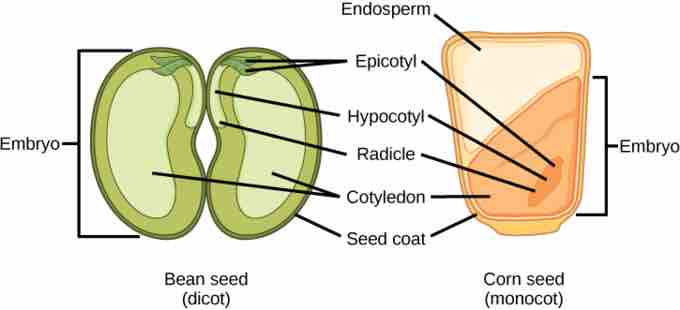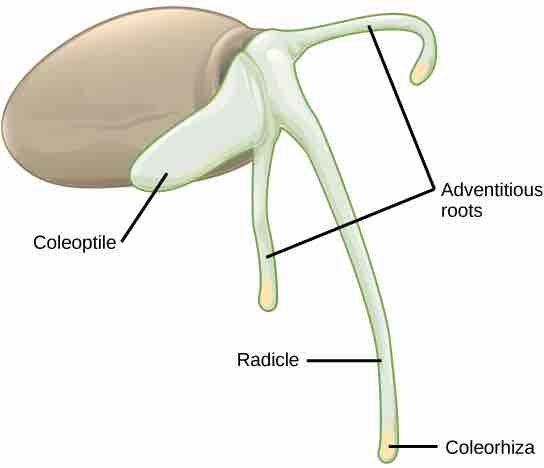Development of the Seed
Parts of a Seed
The seed, along with the ovule, is protected by a seed coat that is formed from the integuments of the ovule sac. In dicots, the seed coat is further divided into an outer coat, known as the testa, and inner coat, known as the tegmen. The embryonic axis consists of three parts: the plumule, the radicle, and the hypocotyl. The portion of the embryo between the cotyledon attachment point and the radicle is known as the hypocotyl. The embryonic axis terminates in a radicle, which is the region from which the root will develop.
Seed Growth
In angiosperms, the process of seed development begins with double fertilization and involves the fusion of the egg and sperm nuclei into a zygote. The second part of this process is the fusion of the polar nuclei with a second sperm cell nucleus, thus forming a primary endosperm. Right after fertilization, the zygote is mostly inactive, but the primary endosperm divides rapidly to form the endosperm tissue. This tissue becomes the food the young plant will consume until the roots have developed after germination. The seed coat forms from the two integuments or outer layers of cells of the ovule, which derive from tissue from the mother plant: the inner integument forms the tegmen and the outer forms the testa. When the seed coat forms from only one layer, it is also called the testa, though not all such testae are homologous from one species to the next.
In gymnosperms, the two sperm cells transferred from the pollen do not develop seed by double fertilization, but one sperm nucleus unites with the egg nucleus and the other sperm is not used. Sometimes each sperm fertilizes an egg cell and one zygote is then aborted or absorbed during early development. The seed is composed of the embryo and tissue from the mother plant, which also form a cone around the seed in coniferous plants such as pine and spruce. The ovules after fertilization develop into the seeds.
Food Storage in the Seed
The storage of food reserves in angiosperm seeds differs between monocots and dicots . In monocots, the single cotyledon is called a scutellum; it is connected directly to the embryo via vascular tissue. Food reserves are stored in the large endosperm. Upon germination, enzymes are secreted by the aleurone, a single layer of cells just inside the seed coat that surrounds the endosperm and embryo. The enzymes degrade the stored carbohydrates, proteins, and lipids. These products are absorbed by the scutellum and transported via a vasculature strand to the developing embryo.

Monocots and dicots
The structures of dicot and monocot seeds are shown. Dicots (left) have two cotyledons. Monocots, such as corn (right), have one cotyledon, called the scutellum, which channels nutrition to the growing embryo. Both monocot and dicot embryos have a plumule that forms the leaves, a hypocotyl that forms the stem, and a radicle that forms the root. The embryonic axis comprises everything between the plumule and the radicle, not including the cotyledon(s).
In endospermic dicots, the food reserves are stored in the endosperm. During germination, the two cotyledons act as absorptive organs to take up the enzymatically-released food reserves, similar to the process in monocots. In non-endospermic dicots, the triploid endosperm develops normally following double fertilization, but the endosperm food reserves are quickly remobilized, moving into the developing cotyledon for storage.
Seed Germination
Upon germination in dicot seeds, the epicotyl is shaped like a hook with the plumule pointing downwards; this plumule hook persists as long as germination proceeds in the dark. Therefore, as the epicotyl pushes through the tough and abrasive soil, the plumule is protected from damage. Upon exposure to light, the hypocotyl hook straightens out, the young foliage leaves face the sun and expand, and the epicotyl continues to elongate. During this time, the radicle is also growing and producing the primary root. As it grows downward to form the tap root, lateral roots branch off to all sides, producing the typical dicot tap root system.
In monocot seeds, the testa and tegmen of the seed coat are fused. As the seed germinates, the primary root emerges, protected by the root-tip covering: the coleorhiza. Next, the primary shoot emerges, protected by the coleoptile: the covering of the shoot tip. Upon exposure to light, elongation of the coleoptile ceases and the leaves expand and unfold. At the other end of the embryonic axis, the primary root soon dies, while other, adventitious roots emerge from the base of the stem . This produces the fibrous root system of the monocot.

Monocot seeds
As this monocot grass seed germinates, the primary root, or radicle, emerges first, followed by the primary shoot, or coleoptile, and the adventitious roots.
Depending on seed size, the time it takes a seedling to emerge may vary. However, many mature seeds enter a period of dormancy marked by inactivity or extremely-low metabolic activity. This period may last for months, years, or even centuries. Dormancy helps keep seeds viable during unfavorable conditions. Upon a return to optimal conditions, seed germination takes place. These conditions may be as diverse as moisture, light, cold, fire, or chemical treatments. Scarification, the softening of the seed coat, presoaking in hot water, or passing through an acid environment, such as an animal's digestive tract, may also be needed.